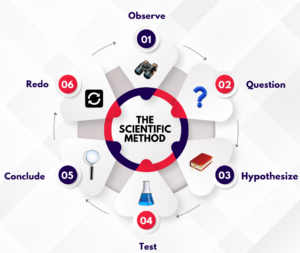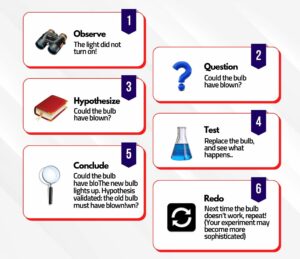Define Scientific Method – 6 step of the scientific method is a procedure of scientific method that has defined science since as early as Aristotle in ancient Greece. What is meant by scientific method, rules in science list, and practical alchemy, which focuses on it, consists of several intentional and logical steps to test an alternative hypothesis. If you grew up in the US, it’s likely that you first learned about the scientific method explained in elementary school when you had to apply it to create a tri-fold backboard science fair project that you displayed and stood next to in your school gymnasium. Why is the Scientific Method used? And what are the scientific processes? Applying Scientific Methodology Step by step, it is also possible that you haven’t directly applied the stages of the scientific meeting to many experimental groups since then.
The Main Steps In the scientific method are the scientific knowledge method steps, which chiefly involve. The six-step scientific method is described below. What are the scientific approach steps? The figure below also summarizes the process of scientific inquiry. List the scientific method in the correct order.
6 scientific method steps in order

steps of scientific investigation
The 6 Steps of the Scientific Method to Trial Law – related example:
Scientific Research Steps
- Observe: Make an observation.
A potential client comes in for a consultation with you and says they were in a car crash where the other driver was found to be under the influence of alcohol, and the potential client’s back has hurt ever since the crash. (You don’t even have to observe this directly!)
- Question: Ask questions about the observation and gather information.
One developed critical thinking question needs to be answered in this case: Did the crash cause the back injury? While there are other questions (e.g., how likely is it that a jury will see it that way? How much is this case worth in damages?), we return to these questions in the next step. When gathering information, you’ll know that you’ve had similar cases that have had positive outcomes for the client, and you’ll look through your client’s medical records to get a clearer picture of the case.
- Hypothesize: Form a hypothesis. A scientific law theory’s new research hypothesis is a testable statement that attempts to explain further observations and make some predictions based on this null hypothesis.
Having examined medical records and with previous research experience, you can formulate a hypothesis is quizlet biology: the car crash caused your client’s back injury. From this hypothesis, we can make predictions (based on the follow-up questions from the last point): We predict that a jury is sufficiently likely also to believe that the crash caused the injury. We might expect the rough value this case might be worth. Let’s say $500,000 is your initial estimate for this example.
- Test: Test the hypothesis and predictions using a reproducible experiment.
At this time, you’d create a survey to ask a representative sample of the general public about the case to measure their sentiment towards it, how much support there is in favor of the plaintiff and defendant, and how much they would award damages to your client.
- Conclude: Analyze Data and the results and draw conclusions, thereby accepting or rejecting the scientific hypothesis.
When you analyze the results, you find that 91% of the sample supports the plaintiff in your case, and the average damages that the sample would award was $750,000. From this, you’d conclude that this case will likely win in a trial, and the jurors would award a lot of money to the plaintiff.
- Redo: 6th Step In Scientific Method. What is a scientific theory Quizlet? The experiment should be reproduced enough times to ensure no inconsistency between its observations/results and scientific theory.
Ideally, in the final step of the scientific method, you’d then repeat this survey to ensure that the first survey’s results didn’t occur as a fluke.

Jury Trials In The Scientific Method
It’s also important to note that the six steps of the scientific method aren’t a straight line – Scientific Process, it’s a circle. Basic Steps In the scientific method, once you’ve concluded from your survey results, you should (or at least could) have new questions. Who developed the Scientific Method, Background research, These questions often sound like, scientific method example “what if I reframed my case like this instead of that?” or “Does talking about this specific fact increase juror support more than this other specific fact?” These questions can be answered with a new survey or in a different method, such as in-person focus groups.
“Baseball isn’t just numbers, it’s not science. If it was, then anybody could do what does trial mean in science we’re doing, but they can’t because they don’t know what we know. They don’t have our experience and they don’t have our intuition.”
Grady Fuson, Oakland Athletics scout, Moneyball (2011 movie)
Who Invented The Scientific Method?
The purpose of the scientific method facts is, at its simplest, to answer questions. While many people in various fields will trust their gut reaction, it’s not always right. For example, the Oakland Athletics, a relatively low salary-cap Major League Baseball team, found that baseball could be reduced to a statistically significant difference after collecting enough experimental data.
This demonstrated that traditional baseball scouts were not especially good at identifying talent: their intuition wasn’t always correct. As such, the Athletics could use simple scientific method examples to identify players more likely to bring success to the team.
How is a scientific law formed?
Trial scientific law isn’t the same as baseball: every case you take on is very different, and there are far fewer cases than baseball pitches. If every lawyer went to trial several hundred times per year, we’d be able to measure lawyer performance analytics to the depth that baseball can! With far fewer data points (in this case, each case is a data point), there’s more room for gut instinct, as data shouldn’t be the only thing used in these cases.
Statistical Data Analysis, Educated Guess, Academic And Professional Scientific Journal Statistical Analysis Significant Difference
Data is likely to be able to answer more nuanced questions logically than gut instinct ever could, such as, “What kind of jurors do I want to keep/remove from my jury?”
Machine learning can create complex predictive models that can confidently make the profile of a plaintiff-perfect (and, conversely, a defendant-perfect) juror far beyond heuristics such as “Republican voters typically award less in damages than Democratic voters” or other such simplistic statements that may not even be true in many scenarios.
Conduct Psychological Research
Lastly, scientists conduct experiments to gain knowledge. This post has talked a lot about using data from the scientific community and the six steps of the scientific method to Trial Law. In reality, you don’t even have to go to trial for the scientific method to be of use. Psychology Research: If you’ve collected data that says that a case is worth x dollars and the defendant offers you a lot less than that during mediation, you can be confident knowing that a jury is likely to award a number much closer to what you’re seeking, despite the defense telling you that it’s a good offer and that you’d be crazy not to accept it.
Dependent Variable Or Independent Variable?
You can go on the offensive and say, “I’ve collected data from 500 potential jurors on this case, and I know it’s worth at least $1,000,000 (or however much the jurors said the case was worth).” The defense may realize that you aren’t just basing your number on a gut instinct like they might have and conclude that the case will cost them much more if it goes to trial.
The six steps of the scientific method allow the scientific community to answer questions about observations and support they’ve made. This includes lawyers who want to determine whether a case is worth taking on regarding whether a jury will likely rule in favor of the plaintiff and how much they will likely award damages.
Empirical Evidence
Empirical evidence can significantly help any plaintiff lawyer, whereas gut feelings – which certainly can be very useful in trial science is tangible – can be limited or even incorrect. Knowing the natural world and what hundreds of members of the public think about your case can provide much more insight than you would have otherwise.
Contact us today to learn more about how The Scientific Method can be applied to your case.
